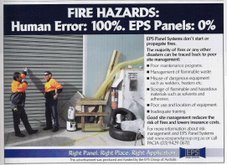
The following report comes from Canterbury University researcher Gregory Baker.*
"A recent ten year study, conducted by industrial and commercial property insurer FM
Global (Battrick, 2001), shows an increase in the contribution of plastic construction materials to fire losses. The study looked at 70 large fire losses over the period 1988-97 that occurred in several countries. In all 70 fires, some type of plastic was both used in the construction of the buildings and a significant factor in the magnitude of the loss. More detailed analysis of the study shows that insulated metal panel constituted 19, or just in excess of one quarter, of the 70 incidents.
"There have been a significant number of fires in the food processing sector in the United Kingdom (UK). In the period 1992-97, 39 such fires were reported to the UK Fire Protection Association (Cooke, 2001b; Day,1998) where insulated panel was used in the construction of the premises. No less than twenty four of these fires occurred in the two year period January 1996 to December 1997 alone.
"The most well publicised fire incident in the UK involving insulated panel occurred at the premises of Sun Valley Poultry Limited in Hereford on September 1993 (Fire
Prevention, 1995b; Harwood and Hume, 1997). The different types of insulated panel
used in the construction of the building had cores of ‘non-combustible mineral wool,
combustible expanded polystyrene and polyurethane’ (Shipp et al, 1997). In this
particular fire, two fire fighters were killed as a result of the insulated panel ceiling collapsing and poor visibility (Cooke, 1997).
"Following the Sun Valley fire, the British Home Office commissioned a report (Shipp et al., 1997) into the fire safety of insulated panel. The first phase of the project involved sending a questionnaire to all fire brigades in the UK requesting information on fire incidents involving insulated panel. Thirty seven brigades responded to the questionnaire, and a total of 21 fire incidents involving insulated panel where analysed.
"Both cold storage and food processing buildings ‘are generally perceived as being of high risk’ (Harwood and Hume, 1997). However, only two of the 21 incidents involved cold storage buildings, while twelve involved food processing facilities and a five more were in factory buildings. The main conclusions drawn from the 21 incidents were that:
• all the fires produced large quantities of black smoke
• firefighting could not be carried out in 8 of the buildings, and in a further three,fire fighters had to evacuate the premises
• the only fatalities occurred in the Sun Valley fire
• in all cases, occupants escaped from the building
"In September 1991, a fire occurred in a chicken processing factory constructed from
insulated panel, located in North Carolina. Of the 90 staff present at the time of the blaze, 25 were killed and a further 54 injured (Morgan and Shipp, 1998).
The most widely publicised fire involving PIP in New Zealand, in recent times, occurred at the Christchurch premises of Ernest Adams Limited in February 2000. The majority of the building was constructed from PIP. One of the New Zealand Fire Service reports that summarised the investigation of the fire incident concluded that ‘the sustained elevated temperatures in the flue assembly were sufficiently high for a fire to occur in the polystyrene [core of the PIP roof panels] and that there was a sufficiently high energy release rate from the flue for this fire to be self sustaining until the fire had grown in size for its own heat release rate to be self sustaining’ (Hefford, 2000).
"The building was virtually totally destroyed by the fire. In addition, four fire fighters were injured in the incident. Two Fire Service personnel were injured as they exited a large roof/ceiling void where the fire initially took hold, while a further two received injuries when a section of ceiling collapsed (NZFS, 2000b). All 75 occupants of the building evacuated successfully.

NZ Fire Service personnel will not enter a burning builidng if it is constructed of EPS panels.
"Following the Ernest Adams fire in Christchurch, the New Zealand Fire Service produced a publication (NZFS, 2000a) dealing with the hazards of fires in buildings constructed from PIP. In relation to fire fighting tactics, the document recommends that personnel should not attempt fire fighting within burning PIP buildings. The bulletin goes on to recommend that rescue entry should only be attempted in extraordinary circumstances, suggesting that ‘successful rescue…is extremely unlikely’ (NZFS, 2000a).
"‘Wide concern over the problems of fighting fires in buildings containing sandwich
panels’ (Morgan and Shipp, 1999) prompted the Fire Research and Development Group
of the British Home Office to commission a report which studied the fire fighting options for fires involving insulated panel. This was deemed necessary because ‘there [was] a clear unusual risk to fire fighters who may have to enter such a [PIP] building on fire’ (Morgan and Shipp, 1998). The majority of the Home Office report provided a summary of a workshop attended by Fire Brigade personnel, where fire fighting options were discussed. The report concluded that British fire brigades were reluctant to adopt the defensive tactic of abandoning a building to destruction even though the dangers of fires in insulated panel buildings were now more apparent."
*Performance of Expanded Polystyrene Insulated Panel Exposed to Radiant Heat
by Gregory B. Baker. A research report presented as partial fulfilment of the requirements for the degree of Master of Engineering in Fire Engineering, Department of Civil Engineering University of Canterbury, Christchurch, New Zealand, February 2002.
Footnote references to be found on http://epsfiretruth.blogspot.com




